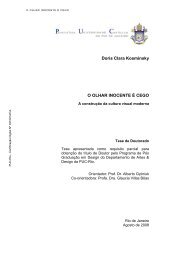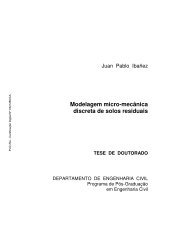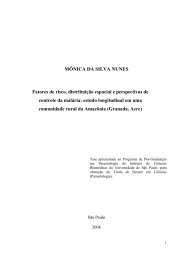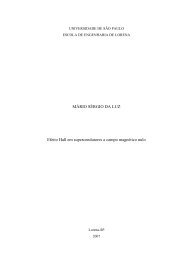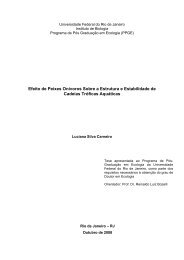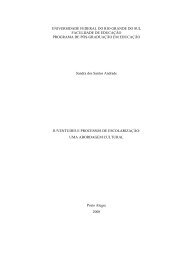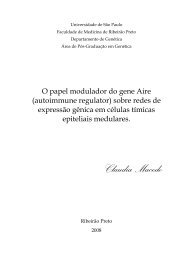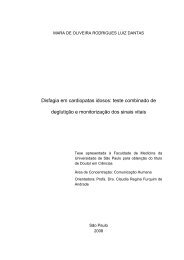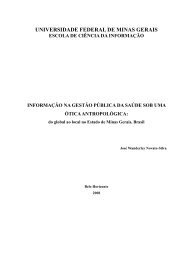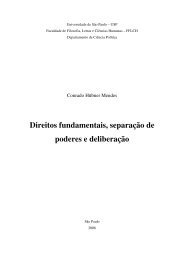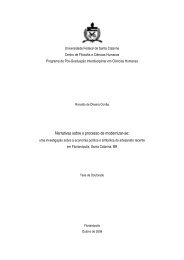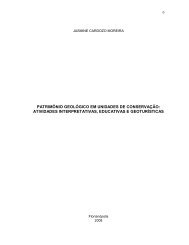2856 R. Cristiano et al. / Tetrahedron 63 (2007) 2851–2858topography of the film of compound 15 is similar to that ofamorphous systems. This trend is in agreement with the differencesobserved in their luminescent and thermal properties.From the AFM images, we obtained the superficialroughness of the films, which is around 16 nm for 14 and7 nm for 15, indicating that the film of sample 15 is flatter.3. ConclusionsIn summary, a series of luminescent V-shaped low molecularmass materials containing a 2,3-dicyanopyrazine centralcore were synthesized and characterized. The photophysicaland thermal properties of these compounds, in solution andin solid state, were evaluated. These compounds displayedfluorescence in the solid state in a wide range of the spectra(from 430 to 512 nm). Most of the materials achieved goodthermal stability, exhibiting an amorphous glassy state aftermelting. Consequently, fluorescent transparent amorphousfilms can be easily obtained from these compounds by spincoating.4.1. General4. ExperimentalInfrared spectra were recorded on a Perkin–Elmer model283 spectrometer in KBr discs or films. 1 H NMR spectrawere obtained with a Varian Mercury Plus 400-MHz instrumentusing tetramethylsilane (TMS) as the internal standard.13 C NMR spectra were recorded on a Varian Mercury Plus100-MHz spectrometer. Elemental analyses were carriedout using a Perkin–Elmer model 2400 instrument. Lowresolutionmass spectra were recorded on a triple quadrupolemass spectrometer, GCMS-QP5050A Shimadzu. The meltingpoints, thermal transitions, and mesomorphic textureswere determined using an Olympus BX50 microscopeequipped with a Mettler Toledo FP-82 hot stage and a PM-30 exposure control unit. DSC measurements were carriedout using Shimadzu equipment with a DSC-50 module. AnHP UV–Vis model 8453 spectrophotometer was used torecord absorption spectra. Fluorescence spectra were recordedon a Hitachi-F-4500. The relative quantum yieldsof fluorescence (F F ) for all compounds are determinedaccording to Eq. 1:F unk ¼ F std ðI unk =A unk ÞðA std =I std Þðh std =h unk Þ 2ð1Þwhere F std is the fluorescence yield of standard quinine sulfate(F std ¼0.546 in 1 M H 2 SO 4 at 298 K); I unk and I std arethe integrated emission intensities of the sample and standard,respectively; A unk and A std are the absorbance of thesample and standard, respectively, at the desired wavelengthl exc (380 nm) such that absorbances were less than 0.10; andh unk and h std are the refractive indexes of the sample andstandard solutions.4.2. MaterialsAll the reagents were obtained from commercial sourcesand used without further purification. In general, all thecompounds were purified by column chromatography on silicagel (70–230 mesh), and crystallization from analyticalgrade solvents. Carboxylic acids 1, 2, 3, and 4 were preparedaccording to published procedures. 15–18 4 0 -(3,4,5-Tridodecyloxybenzoyloxy)benzoicacid 5 was obtained from theiterative esterification of 3,4,5-tridodecyloxybenzoic acid2 with benzyl-4-hydroxybenzoate followed by deprotectionof the benzyl ester through a modified version of a proceduregiven in the literature. 19 Acid 6 was synthesized throughWilliamson etherification of methyl 3,4,5-trihydroxybenzoatewith 4-n-dodecyloxybenzyl bromide, followed byalkaline ester cleavage according to a method described indetail elsewhere. 20 Anisil 7 was synthesized through benzoincondensation of anisaldehyde 21 followed by hydroxyloxidation using copper(II) sulfate/pyridine. 22 Compound9 was synthesized according to a procedure given in theliterature. 224.3. X-ray crystallographic analysisSuitable crystals of 8 were obtained through recrystallizationfrom methanol followed by filtration of the crystals andwashing with cold methanol. Crystallographic analysiswas carried out at room temperature with a selected prismaticyellow crystal, which was mounted on a CAD-4Enraf–Nonius diffractometer using graphite monochromatedMo Ka radiation (l¼0.71073 Å). Cell parameters weredetermined from 25 centered reflections in the q range of4.96 –16.99 . Intensities of 3130 were collected using theu 2q scan technique with a q angle ranging from 1.65 to25.07 . The structure was solved using direct methodswith SIR-97 23 and refined by full-matrix least-squares procedureson F 2 using SHELXL-97. 24 H atoms bonded to Catoms were added at their calculated positions and includedin the structure factor calculations, with C–H distances andU eq taken from the default of the refinement program.Selected crystal data: C 20 H 14 N 4 O 2 , M¼342.35, monoclinic,P2 1 /n, a¼9.498(1) Å, b¼7.38(1) Å, c¼24.664(2) Å, b¼93.72(1) , V¼1726.0(3) Å 3 , Z¼4, D calcd ¼1.317 Mg/m 3 ,m¼0.089 mm 1 , F(000)¼712, unique 3056 (R int ¼0.0147),refined parameters¼237, Goof (F 2 )¼1.032, R 1 [I>2s(I)]¼0.0422, wR 2 (all data)¼0.1207.Crystallographic data (excluding structure factors) for thestructure reported in this paper have been deposited at theCambridge Crystallographic Data Centre under supplementarypublication number CCDC 623033. Copies of the datacan be obtained, free of charge, on application to CCDC,12 Union Road, Cambridge, CB2 1EZ, UK [fax: +44(0)1223 336033, e-mail: deposit@ccdc.cam.ac.uk or http://www.ccdc.cam.ac.uk)].4.4. Film preparation and characterizationThe films were deposited on quartz plates for the opticalabsorption and emission measurements. Before deposition,the plates were first carefully cleaned by washing withneutral detergent and then, followed by a sequence of20-min sonications in acetone, alcohol, and water, andfinally dried in an oven. The studied compounds weredissolved in chloroform, at 2% (wt), and then depositedby spin coating at 4000 rpm for 30 s, at room temperature(24 C).
R. Cristiano et al. / Tetrahedron 63 (2007) 2851–28582857signal, Ar–H), 7.67 (d, J¼8.8 Hz, 4H, Ar–H), 8.12 (d,The quality of solid films obtained from samples 14 and 154H, Ar–H), 7.28 (d, J¼8.8 Hz, 4H overlapped with CDCl 3 29.6, 29.8, 32.1, 68.6, 113.3, 114.6, 121.0, 122.5, 122.7,was observed with an atomic force microscope (AFM),using MI (Molecular Imaging Model IC 301) in contactmode, at a 2.60 Hz scanning rate and 256256 lines.J¼8.8 Hz, 4H, Ar–H). 13 C NMR (CDCl 3 ) d ppm: 14.1,22.6, 25.9, 29.1, 29.3, 29.4, 29.6, 31.9, 68.4, 113.1, 114.4,120.8, 122.5, 129.7, 131.2, 132.3, 132.4, 153.6, 154.3, 163.9,164.3. Elemental analysis for C 52 H 58 N 4 O 6 , calcd: C, 74.79;4.5. Synthesis of 2,3-dicyanopyrazine ringA mixture of compound 7 or 9 (10 mmol), diaminomaleonitrile(1.3 g, 12 mmol), and catalytic amount of p-toluenesulfonicacid in methanol (20 mL) was heated under refluxovernight. After cooling, the precipitate was filtered andwashed with cold methanol to give the crude product as ayellow powder.H, 7.00; N, 6.71. Found: C, 74.33; H, 7.04; N, 6.60%.4.6.2. 2,3-Dicyano-5,6-bis-4-(3,4,5-tridodecyloxybenzoyloxy)phenylpyrazine (12). The crude product was purifiedby column chromatography (eluant dichloromethane) togive a yellow wax. Yield: 67%; mp 52.5–55.4 C. IR (film)n max cm 1 : 2920, 2854, 1724 (C]O), 1591, 1504, 1433,1331, 1179, 1111, 945. 1 H NMR (CDCl 3 ) d ppm: 0.87 (m,18H, –CH 3 ), 1.25–1.48 (br, 108H, –CH 2 –), 1.81–1.85 (m,4.5.1. 2,3-Dicyano-5,6-bis(4-methoxyphenyl)pyrazine(8). The solid was recrystallized from acetonitrile. Yield:12H, –CH 2 CH 2 O–), 4.02–4.08 (m, 12H, –CH 2 O–), 7.27(d, J¼8.4 Hz, 4H overlapped with CDCl 3 signal, Ar–H),85%; mp 190.2–190.6 C. IR (KBr pellet) n max cm 1 : 7.38 (s, 4H, Ar–H), 7.68 (d, J¼8.4 Hz, 4H, Ar–H). 13 C2967, 2838, 2233 (C^N), 1603, 1504, 1376, 1260, 1175,1024, 840. 1 H NMR (CDCl 3 ) d ppm: 3.85 (s, 6H, CH 3 O),6.87 (d, J¼6.8 Hz, 4H, Ar–H), 7.54 (d, J¼6.8 Hz, 4H,Ar–H). 13 C NMR (CDCl 3 ) d ppm: 55.7, 113.7, 114.5,127.9, 128.9, 131.7, 154.5, 162.2. Elemental analysis forNMR (CDCl 3 ) d ppm: 14.4, 22.9, 26.3, 29.5, 29.6, 29.9,30.6, 32.2, 69.5, 73.9, 108.8, 113.3, 122.8, 123.4, 129.9,131.5, 132.7, 143.5, 153.2, 153.7, 154.5, 164.7. Elementalanalysis for C 104 H 162 N 4 O 10 , calcd: C, 76.71; H, 10.03; N,3.44. Found: C, 76.24; H, 10.35; N, 3.22%.C 20 H 14 N 4 O 2 , calcd: C, 70.17; H, 4.12; N, 16.37. Found: C,69.89; H, 4.15; N, 16.18%.4.6.3. 2,3-Dicyano-5,6-bis-4-(4-decyloxy-4-phenylbenzoyloxy)phenylpyrazine (13). The crude product was purified4.5.2. 2,3-Dicyano-5,6-bis(4-hydroxyphenyl)pyrazine(10). The crude product was purified by column chromatography(eluant hexane/ethyl acetate 1:1). Yield: 78%; mp185 C (dec). IR (KBr pellet) n max cm 1 : 3407 (OH), 2250(C^N), 2213, 1607, 1590, 1497, 1373, 1274, 1173, 1106.H NMR (CDCl 3 ) d ppm: 6.86 (d, J¼8.8 Hz, 4H, Ar–H),7.50 (d, J¼8.8 Hz, 4H, Ar–H), 9.10 (s, 2H, ArO–H). 13 CNMR (CDCl 3 ) d ppm: 114.3, 115.7, 127.6, 129.0, 131.9,154.8, 160.2. Elemental analysis for C 18 H 10 N 4 O 2 , calcd:C, 68.79; H, 3.21; N, 17.83. Found: C, 68.70; H, 3.45; N,17.49%. MS (EI, 70 eV) m/z (%): [M + ] 314 (88%),by heating in acetonitrile (40 mL) and the solid filteredoff as a light yellow powder. Yield: 70%; mp 170.0–172.5 C. IR (film) n max cm 1 : 2921, 2851, 1734 (C]O),1600, 1501, 1377, 1266, 1186, 1063, 825. 1 H NMR (CDCl 3 )d ppm: 0.89 (t, 6H, CH 3 ), 1.28–1.48 (br, 28H, –CH 2 –), 1.81–1.85 (m, 4H, –CH 2 CH 2 O–), 4.02 (t, 4H, –CH 2 O–), 7.00 (d,J¼8.4 Hz, 4H, Ar–H), 7.29 (d, J¼8.4 Hz, 4H, Ar–H), 7.59(d, J¼8.4 Hz, 4H, Ar–H), 7.70 (d, J¼8.0 Hz, 8H, Ar–H),8.22 (d, J¼8.4 Hz, 4H, Ar–H). 13 C NMR (CDCl 3 ) d ppm:14.4, 22.9, 26.3, 29.5, 29.6, 29.7, 29.8, 32.1, 68.4, 113.3,115.2, 122.8, 126.9, 127.0, 128.6, 129.9, 131.0, 131.5,[M + +1] 315 (19%), [M + +2] 316 (2%), [M + 1] 313 (49%), 131.9, 132.6, 146.6, 153.7, 154.5, 159.9, 164.7. Elemental297 (28%), 119 (100%).analysis for C 64 H 66 N 4 O 6 , calcd: C, 77.86; H, 6.74; N,5.68. Found: C, 77.48; H, 6.80; N, 5.43%.4.6. Esterification procedure for final compounds 11–134.7. Esterification procedure for final compounds 14–16The corresponding carboxylic acid 1, 2, or3 (2 mmol) andthionyl chloride (0.19 mL, 2.6 mmol) in dichloromethane(20 mL) were heated under reflux for 4 h. The solvent andexcess of thionyl chloride were evaporated under vacuumaffording the acid chloride, which was used without furtherpurification. To a three-necked round bottomed flask withA mixture of 10 (0.314 g, 1 mmol), the correspondingcarboxylic acid 4, 5, or 6 (2 mmol), DCC (0.494 g,2.4 mmol), and a catalytic amount of DMAP in dichloromethane(40 mL) was stirred at room temperature under argonatmosphere for 24 h. The resulting precipitate was filteredargon inlet–outlet containing compound 10 (0.314 g, off and washed with dichloromethane (50 mL). The solvent1 mmol) dissolved in dichloromethane (30 mL) and triethylamine(5 mL), the respective acid chloride in 5 mL ofwas evaporated and the crude product was purified by columnchromatography (eluant dichloromethane).dichloromethane was added dropwise. The reaction mixturewas then stirred at room temperature for 20 h. The solventswere evaporated to give the crude products.4.7.1. 2,3-Dicyano-5,6-bis-4-[4-(4-decyloxybenzoyloxy)-benzoyloxy]phenyl pyrazine (14). White solid. Yield:74%, mp 134.3–136.7 C. IR (film) n max cm 1 : 2924,4.6.1. 2,3-Dicyano-5,6-bis-4-(4-decyloxybenzoyloxy)-phenyl pyrazine (11). The crude product was recrystallizedfrom acetonitrile as a light yellow powder. Yield: 89%; mp113.6–115.0 C. IR (KBr pellet) n max cm 1 : 2918, 2850,2240 (C^N, weak), 1736 (C]O), 1602, 1507, 1377,1256, 1202, 1159, 1058. 1 H NMR (CDCl 3 ) d ppm: 0.88(t, 9H, –CH 3 ), 1.28–1.47 (br, 28H, –CH 2 –), 1.82 (m, 4H,–CH 2 CH 2 O–), 4.04 (t, 4H, –CH 2 O–), 6.97 (d, J¼8.8 Hz,2852, 2375 (C^N, weak), 1736 (C]O), 1602, 1508, 1376,1260, 1202, 1160, 1052. 1 H NMR (CDCl 3 ) d ppm: 0.89 (t,6H, CH 3 ), 1.28–1.48 (br, 28H, –CH 2 –), 1.79–1.86 (m, 4H,–CH 2 CH 2 O–), 4.05 (t, 4H, –CH 2 O–), 6.99 (d, J¼8.4 Hz,4H, Ar–H), 7.32 (d, J¼8.4 Hz, 4H, Ar–H), 7.38 (d,J¼8.4 Hz, 4H, Ar–H), 7.70 (d, J¼8.4 Hz, 4H, Ar–H), 8.15(d, J¼8.4 Hz, 4H, Ar–H), 8.27 (d, J¼8.4 Hz, 4H, Ar–H).C NMR (CDCl 3 ) d ppm: 14.4, 22.9, 26.2, 29.3, 29.5,
- Page 2 and 3:
AUTOBIOGRAFIARodrigo Cristiano nasc
- Page 5 and 6:
Rodrigo CristianoMATERIAIS MOLECULA
- Page 7 and 8:
À minha esposa Cláudia.
- Page 9 and 10:
VÍNDICEINTRODUÇÃO ..............
- Page 11 and 12:
VIILISTA DE FIGURASFigura 1. Proces
- Page 13 and 14:
IXFigura 31. Espectro de RMN de 1 H
- Page 15 and 16:
XIFigura 63. Espectros de (a) UV e
- Page 17 and 18:
XIIILISTA DE TABELASTabela 1. Os ti
- Page 19 and 20:
XVTGA - Análise termogravimétrica
- Page 21 and 22:
XVIIABSTRACTThe synthesis and chara
- Page 23 and 24:
Introdução 19A química orgânica
- Page 25 and 26:
Introdução 21fenômenos possuem t
- Page 27 and 28:
Introdução 23elétrico é aplicad
- Page 29 and 30:
Introdução 25(Figura 3). A verdad
- Page 31 and 32:
Introdução 27investigar a conexã
- Page 33 and 34:
Introdução 29com um banco de dado
- Page 35 and 36:
Introdução 31descrever a estrutur
- Page 37 and 38:
Introdução 33Nas fases esméticas
- Page 39 and 40:
Introdução 35OHC 6 H 13OOOC 11 H
- Page 41 and 42:
Introdução 37O interesse na sínt
- Page 43 and 44:
Introdução 39Figura 17. Represent
- Page 45 and 46:
Introdução 41Figura 19. Esquema d
- Page 47 and 48:
Introdução 43mais comum nesses ma
- Page 49 and 50:
Introdução 45formam estruturas su
- Page 51 and 52:
Introdução 47do material quando n
- Page 53 and 54:
Introdução 491,3,4-oxadiazolN NOO
- Page 55 and 56:
Introdução 51R 2 OR 1OR 2N N ONON
- Page 57 and 58:
Introdução 53estável através de
- Page 59 and 60:
RESULTADOS EDISCUSSÃO
- Page 61 and 62:
Resultados e Discussão 57aromátic
- Page 63 and 64:
Resultados e Discussão 59Esquema 3
- Page 65 and 66:
Resultados e Discussão 61mantendo-
- Page 67 and 68:
Resultados e Discussão 63(ν C≡C
- Page 69 and 70:
Resultados e Discussão 65funcional
- Page 71 and 72:
Resultados e Discussão 67ROORROOO4
- Page 73 and 74:
Resultados e Discussão 69Uma rota
- Page 75 and 76:
Resultados e Discussão 71baNNOc d
- Page 77 and 78:
Resultados e Discussão 73Tabela 3.
- Page 79 and 80:
Resultados e Discussão 75Para o co
- Page 81 and 82:
Resultados e Discussão 77porque o
- Page 83 and 84:
Resultados e Discussão 795. CLs cu
- Page 85 and 86:
Resultados e Discussão 81gerado a
- Page 87 and 88:
Resultados e Discussão 835.2. Prop
- Page 89 and 90:
Resultados e Discussão 85(a)Cr-CrC
- Page 91 and 92:
Resultados e Discussão 87(a)(b)Fig
- Page 93 and 94:
Resultados e Discussão 89Esses com
- Page 95 and 96:
Resultados e Discussão 91catalíti
- Page 97 and 98:
Resultados e Discussão 93a complet
- Page 99 and 100:
Resultados e Discussão 95A banda l
- Page 101 and 102:
Resultados e Discussão 97constante
- Page 103 and 104:
Resultados e Discussão 99A não-pl
- Page 105 and 106:
Resultados e Discussão 101(a)(b)T
- Page 107 and 108:
Resultados e Discussão 103(e)trans
- Page 109 and 110:
Resultados e Discussão 1056.5. Pro
- Page 111 and 112:
Resultados e Discussão 107composto
- Page 113 and 114:
Resultados e Discussão 109composto
- Page 115 and 116:
Resultados e Discussão 1117. Tris-
- Page 117 and 118:
Resultados e Discussão 113Esquema
- Page 119 and 120:
Resultados e Discussão 115A caract
- Page 121 and 122:
Resultados e Discussão 117ppm rela
- Page 123 and 124:
Resultados e Discussão 1197.2. Est
- Page 125 and 126:
Resultados e Discussão 121Figura 7
- Page 127 and 128:
Resultados e Discussão 123N21-N22
- Page 129 and 130:
Resultados e Discussão 125método
- Page 131 and 132:
Resultados e Discussão 127após lo
- Page 133 and 134:
Resultados e Discussão 129baseado
- Page 135 and 136:
Resultados e Discussão 131aquecime
- Page 137 and 138:
Resultados e Discussão 133composto
- Page 139 and 140:
Resultados e Discussão 1357.5. Est
- Page 141 and 142:
Resultados e Discussão 137estabili
- Page 143 and 144:
Conclusões 1398. CONCLUSÕESEm ger
- Page 145 and 146:
SEÇAO EXPERIMENTAL
- Page 147 and 148:
Seção Experimental 143respectivam
- Page 149 and 150:
Seção Experimental 1457,08 (m, 2H
- Page 151 and 152:
Seção Experimental 147K 2 CO 3 (7
- Page 153 and 154:
Seção Experimental 149H, -CH 2 NC
- Page 155 and 156:
Seção Experimental 1512918, 2851,
- Page 157 and 158:
Seção Experimental 153Esse compos
- Page 159 and 160:
Seção Experimental 155Espectro de
- Page 161 and 162:
Seção Experimental 157Este compos
- Page 163 and 164:
Seção Experimental 159H 21 C 10 O
- Page 165 and 166:
Seção Experimental 16114,36; 22,9
- Page 167 and 168:
Seção Experimental 163H), 6,85 (d
- Page 169 and 170:
Seção Experimental 165NCNCNNHO59O
- Page 171 and 172:
Seção Experimental 167H 21 C 10 O
- Page 173 and 174:
Seção Experimental 169(sílica-ge
- Page 175 and 176:
Seção Experimental 171dodeciloxib
- Page 177 and 178:
Seção Experimental 173NCNCNNOOOOC
- Page 179 and 180:
Seção Experimental 175Análise el
- Page 181 and 182: Seção Experimental 177Espectro de
- Page 183 and 184: Seção Experimental 179131,6; 132,
- Page 185 and 186: Seção Experimental 181Espectro de
- Page 187 and 188: Seção Experimental 183fornecendo
- Page 189 and 190: Seção Experimental 185Espectro de
- Page 191 and 192: Referências bibliográficas 18710.
- Page 193 and 194: Referências bibliográficas 189pha
- Page 195 and 196: Referências bibliográficas 19149.
- Page 197 and 198: Referências bibliográficas 19371.
- Page 199 and 200: Referências bibliográficas 19596.
- Page 201 and 202: Referências bibliográficas 197120
- Page 203 and 204: 382 R. Cristiano et al.acetylenes 1
- Page 205 and 206: 384 R. Cristiano et al.Scheme 2. Re
- Page 207 and 208: 386 R. Cristiano et al.Table 3. Sum
- Page 209 and 210: 388 R. Cristiano et al.117.0-125.4u
- Page 211 and 212: 390 Hockey stick-shaped LC compound
- Page 213 and 214: LSYC146630 LSYC_036_007 Techset Com
- Page 215 and 216: LSYC146630 LSYC_036_007 Techset Com
- Page 217 and 218: LSYC146630 LSYC_036_007 Techset Com
- Page 219 and 220: LSYC146630 LSYC_036_007 Techset Com
- Page 221 and 222: 998 R. Cristiano et al.block contai
- Page 223 and 224: 1000 R. Cristiano et al.(a)(b)Figur
- Page 225 and 226: 1002 R. Cristiano et al.4.3.2. 1-(4
- Page 227 and 228: Tetrahedron 63 (2007) 2851-2858Synt
- Page 229 and 230: R. Cristiano et al. / Tetrahedron 6
- Page 231: R. Cristiano et al. / Tetrahedron 6
- Page 235 and 236: COMMUNICATIONwww.rsc.org/chemcomm |
- Page 237: In summary, we performed the synthe



